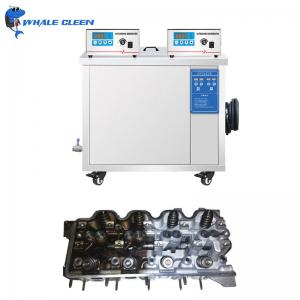
Add to Cart
1.5KW Ultrasonic Parts Cleaner SUS304 Tank Ultrasound Washing Machine
How Ultrasonic Cleaner Work? Company Overview And Catalog Of Blue Whale and Jie...
Ultrasonic cleaning is a process that uses ultrasound (usually from 20–400KHz) to agitate a fluid. The ultrasound can be used with just water, but use of a solvent appropriate for the item to be cleaned and the type of soiling present enhances the effect. Cleaning normally lasts between three and six minutes, but can also exceed 20 minutes, depending on the object to be cleaned.
The Comparison Of Ultrasonic Cleaning And Traditional Cleaning:
| Comparing Item | Traditional Cleaning | Ultrasonic Cleaning |
| Cleaning Time | Slower | Faster |
| Safety Level | Low | High |
| Labor Cost | High | Nearly Zero Labor Cost |
| Harmful Level | Sometimes It Will Be Harmful | Nearly Zero Harm |
Application:
| Industry | Cleaning Objects |
| Auto industry | engine parts, gear box, shock absorber, auto nozzle, cylinder, valve, Carburetors |
| Electrnoincs | PCB board, electronic parts, TV parts, computer parts |
| Aerospace and marine parts | Turbine blades, Marine Engine components, Overhaul parts, Pneumatics |
| Machinery | Moulds, precision parts, pressing parts, camera parts, bearing, hardware tools |
| Plating and Painting | polishing parts, SUS cutter, tableware, plating |
| Food industry | Oven tray, boiler, bottles, bottle cap, Hood Filters |
| Optical& watch tool | optical lens, eyeglass, sunglass, metal, gold, jewelry, diamond, watch band, watch cover, watch hand |
| Jewelry | Jewelry, diamond, gold, silver products |
| Dental and Medical | Dental Device, Medical Implant, beakers, bottles, vials, pipettes, or other labware. |
Customers' Feefdback

Our advantages/Service
1. Help customer analyze product project and provide solution.
2. Freely sample test.
3. Skilled jig design services.
4. Provide shipping/delivery information checking service.
5. One year guarantee, all life maintain promise.
6. 24 hours feedback speed by email of others.
FAQ:
1. What is Cavitation and Implosion?
The phenomenon of cavitation is unique in fluids. The cavitation bubbles implode, releasing high energy locally. This implosion is the heart of the ultrasonic process.
An ultrasonic system works by inducing controlled cavitation in the cleaning fluid. Cavitation refers to microscopic voids or "bubbles" that form when the transducers emit sufficient ultrasonic energy into the fluid. The cavitation bubbles form relatively slowly and then collapse suddenly, releasing tremendous energy against the surfaces of objects immersed in the tank that ‘scrubs’ hard to remove soils from the parts.
3. Can ultrasonic cleaning damage parts?
Ultrasonic cleaning is considered safe for most parts; although in some cases it is necessary to observe caution. Although the effect of thousands of implosions per second is very powerful, the cleaning process is safe.